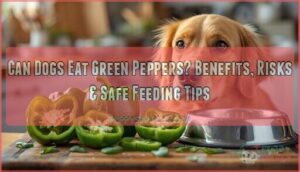This site is supported by our readers. We may earn a commission, at no cost to you, if you purchase through links.

Stick to plain, unsalted crackers and only offer them in small amounts as an occasional treat.
Many crackers are high in salt, sugar, or other ingredients like garlic or onion, which can harm your dog.
Even too many “safe” crackers can lead to weight gain or upset stomachs.
Think of crackers as a nibble, not a meal.
A better option? Try dog-friendly fruits or veggies for a safer crunch.
Always check labels and, when in doubt, ask your vet.
Your dog’s health is worth the extra effort!
Table Of Contents
- Key Takeaways
- Dogs Eating Crackers
- Can Dogs Eat Crackers
- Safe Cracker Types
- Crackers to Avoid
- Feeding Guidelines
- Cracker Ingredients
- Health Risks Explained
- Dog Size and Crackers
- Alternatives to Crackers
- Cracker Safety Precautions
- Frequently Asked Questions (FAQs)
- Can dogs eat crackers without getting sick?
- Is it safe for dogs to eat pickles?
- Are crackers bad for dogs?
- Can dogs eat cheese crackers?
- Can dogs eat fish crackers?
- Can dogs eat water crackers?
- Are crackers safe for dogs to eat?
- Can dogs have Jacobs crackers?
- Is it safe to give my dog crackers as a reward?
- Are crackers suitable for all breeds of dogs?
- Conclusion
Key Takeaways
- Stick to plain, unsalted crackers and give them sparingly as occasional treats to avoid health risks.
- Avoid crackers with harmful ingredients like garlic, onion, high salt, or sugar, which can be toxic to dogs.
- Watch for signs of health issues like dehydration, upset stomach, or weight gain after giving crackers.
- Healthier alternatives like dog-friendly fruits and veggies are safer and more nutritious for your pup.
Dogs Eating Crackers
You might wonder if your dog can safely enjoy crackers as a snack. While some crackers are fine in small amounts, others can contain harmful ingredients that pose health risks.
Safe Cracker Options
If you’re curious about safe crackers for dogs, stick to plain, unsalted crackers or low-sugar options like graham crackers.
Peanut butter crackers are safe if xylitol-free, while homemade recipes allow control over ingredients.
Healthy alternatives include crackers with simple, natural ingredients, and it’s essential to keep portions small—crackers should be an occasional treat, not a dietary staple, for canine health.
Toxic Ingredients
Some cracker ingredients can harm dogs.
Garlic toxicity and onion dangers are serious.
These can cause anemia risks and upset stomachs.
Xylitol, salt poisoning, chocolate, and even nutmeg are toxic to dogs.
Always check the label—avoiding crackers flavored with unsafe ingredients protects your pup.
Their safety matters more than sharing a snack.
Stick to dog-friendly treats!
Health Risks
Crackers may seem harmless, but the health risks for dogs are real.
Crackers might look harmless, but their hidden risks can impact your dog’s health more than you realize.
Sodium overload from salty crackers can lead to dehydration or serious issues like high blood pressure. Sugar content contributes to weight gain and dental problems.
Toxic additives, like garlic or onion, can trigger digestive issues or worse. Even small amounts might cause allergic reactions. Are crackers bad for dogs? Often, yes.
Can Dogs Eat Crackers
Sure, dogs can eat crackers, but there’s more to it than a simple yes or no. Crackers aren’t toxic on their own, but they lack nutritional value for dogs.
It’s all about moderation and the right kind of cracker. Some ingredients found in crackers, like garlic or high salt content, can be harmful to dogs. Even safe crackers should only be given as occasional snacks.
When deciding if crackers are a good snack for your dog, consider these factors:
- Nutritional Value: Most crackers are empty calories with little benefit.
- Wheat Allergies: Dogs sensitive to wheat might experience digestive upset.
- Cracker Digestion: Too many crackers can cause stomach issues or weight gain.
It’s best to stick with small portions and dog-safe options.
Safe Cracker Types
Not all crackers are safe for your dog, but some plain options can be given in moderation. It’s important to check ingredients carefully and stick to simple, unsalted varieties.
Plain Crackers
Plain crackers are a safe snack for dogs when given in limited quantities.
Choose unsalted options to avoid high sodium levels, which could cause digestive issues. Stick to plain crackers without additives or flavorings.
For safety, always check labels and avoid overly processed brands. Many owners purchase crackers for dogs online.
These simple recipes of safe brands make occasional treats, not everyday meals.
Graham Crackers
Graham crackers can be a safe snack for your dog in moderation, but there are a few things to watch out for.
Avoid flavors like honey or cinnamon, as these aren’t ideal. Always check labels for xylitol or chocolate additives, which are toxic to dogs.
- Stick to plain varieties.
- Avoid sweetened options.
- Look for safe brands.
- Limit serving sizes.
- Monitor for reactions.
Saltine Crackers
Saltine crackers aren’t the worst snack for dogs, but they’re far from ideal.
With their high sodium content, even a couple can bump up your pup’s salt intake. Small dogs are especially at risk.
Large dogs might handle a bit better, but portion control is key. Always keep fresh water handy to meet your dog’s hydration needs after any salty treat.
These crackers offer minimal nutritional value, making them a less desirable treat option with minimal benefits.
Ritz Crackers
Ritz crackers have no toxic ingredients, but they’re not an ideal treat for dogs.
Their high fat, salt, and carb content can disrupt digestion and lead to health issues. Small amounts won’t harm most dogs, but watch for Ritz allergies or upset stomachs.
Safer Ritz alternatives include plain crackers or dog-safe snacks prepared specifically for balanced nutrition. Choose wisely!
Crackers to Avoid
Not all crackers are safe for your dog, and some can even be dangerous.
Crackers with garlic, onion, too much salt, or sugar should always be avoided to protect your pet’s health.
Garlic Crackers
Garlic crackers are a no-go for dogs.
Garlic toxicity can trigger anemia, nausea, and even vomiting.
These seasoned snacks often hide unsafe ingredients like onion powder too.
Always check labels since even small amounts of garlic can harm.
Stick with safe alternatives like plain crackers or vet-approved treats.
If ingestion happens, take immediate action and call your vet.
Remember, garlic can be very harmful, so it’s crucial to be cautious with the snacks you give to your dog.
Onion Crackers
Onion crackers are toxic for dogs due to onion poisoning risks. Even trace amounts can harm dog health by causing anemia.
Check ingredient labels carefully to avoid onion powder lurking in crackers. As a safer alternative, consider that fresh fruits work well as treats.
Protect your pup with these steps:
- Avoid all onion-flavored crackers.
- Store human snacks away from pets.
- Offer safe alternatives like plain crackers.
- Seek immediate action if ingestion occurs.
High Sugar Crackers
High sugar crackers aren’t a good snack for dogs.
Excessive sugar can lead to obesity risks, dental problems, and even diabetes concerns.
Instead of sweets, stick to ingredient alternatives like plain, unsalted crackers or natural treats like fruits.
Always prioritize safe quantities—just a small piece if necessary.
Keeping dogs healthy starts with careful choices and avoiding sugary temptations.
Salted Crackers
Salted crackers aren’t great for dogs, no matter how harmless they seem.
Their high sodium content can trigger health issues like dehydration, high blood pressure, or sodium poisoning, especially in small breeds.
Stick to a tiny serving size if you must share, but it’s safer to opt for dog-friendly treats.
Always keep hydration concerns in mind and monitor for reactions.
Feeding Guidelines
You should only give your dog crackers in very small amounts and not as a regular treat.
Stick to plain, unsalted types, and always check the ingredients to avoid harmful additives.
Portion Control
In the context of giving dogs crackers as snacks, portion control matters.
Stick to one or two crackers to avoid overloading them with empty calories.
Treat frequency should remain low—think of crackers as an occasional treat, not a daily habit.
Size matters too—smaller dogs need even less.
Always offer fresh water to meet hydration needs.
Moderation is key!
Monitoring Health
Watch for signs of trouble after giving dogs crackers.
Keep an eye on their stool consistency, hydration levels, and weight management.
Sudden behavior changes like lethargy could signal a problem.
Dogs with allergies need careful monitoring, as crackers’ sodium content or other ingredients may trigger reactions.
Always make certain clean water is available to support their overall health and monitor for any signs of trouble, especially in dogs with allergies.
Balanced Diet
Balancing your dog’s diet goes beyond avoiding too many crackers. Snacks shouldn’t replace nutrient-rich meals. Prioritize proper nutrient ratios and monitor daily caloric intake to maintain their health.
- Make certain fresh water to address hydration importance.
- Use dietary supplements only with a veterinary consultation.
- Replace empty-calorie treats with protein-rich options.
- Focus on providing natural meals with fruits, vegetables, or approved dog treats.
Cracker Ingredients
When choosing crackers for your dog, it’s important to read the ingredient list carefully.
Look for options with no added salt, low sugar, and natural ingredients to avoid harmful effects on your pet’s health.
Unsalted Options
Unsalted crackers can be a safer treat for dogs, thanks to their lower sodium content.
Always choose vet-approved options with simple ingredients.
Moderation is key, so limit portion sizes.
Some owners even purchase crackers made for dogs as a special treat.
| Type | Sodium Concerns | Safe Alternatives | Homemade Recipes |
|---|---|---|---|
| Shibolim Whole Grain | Very Low Sodium | Yes | Whole Wheat Dog Biscuits |
| Plain Wheat Crackers | Low Sodium | Yes | Rice-Based Crackers |
| Rice Crackers | No Added Salt | Yes | Dog-Friendly Oatmeal Treats |
| Homemade Treats | Customizable Sodium | Yes | Peanut Butter & Oats |
Always check ingredients!
Low Sugar Options
If you’re considering crackers with reduced sugar for your dog, look for Sugar-Free Crackers made with natural sweeteners like honey or molasses.
Avoid anything overly processed or packed with artificial additives. Healthy Alternatives, like Safe Fruits or Vegetable Treats, often work better as snacks.
For low sugar options, consider exploring online resources.
Dogs don’t need sugar, so keep cracker treats occasional and light!
Natural Ingredients
When choosing crackers with natural ingredients for your dog, skip artificial stuff and aim for wholesome goodness.
Look for organic crackers and safe additives like natural preservatives. Homemade recipes let you control ingredient sourcing and avoid risky components.
- Pick crackers with simple, dog-safe recipes.
- Avoid long ingredient lists.
- Use homemade treats for peace of mind.
- Skip crackers loaded with additives or sugar.
Health Risks Explained
Feeding your dog crackers might seem harmless, but it comes with potential health risks you should know about.
Issues like dehydration, high blood pressure, and sodium poisoning can arise if your dog consumes too many or the wrong type of crackers.
Dehydration
Crackers with too much sodium can cause rapid dehydration in dogs.
Signs of dehydration include lethargy, dry gums, and excessive panting.
A dog’s water intake is essential to maintain proper electrolyte balance, especially after eating salty crackers.
Always provide fresh water post-cracker hydration to avoid dehydration symptoms, and limit crackers to an occasional treat and prioritize a balanced diet.
High Blood Pressure
Too much sodium from crackers can spike your dog’s blood pressure.
High blood pressure stresses the heart and might lead to kidney damage or other health issues like cellular dehydration.
Dogs with anemia face higher risks since their bodies already strain to function.
Stick to low-salt snacks and always check the salt content before treating your pup to prevent issues like kidney damage.
Sodium Poisoning
Too much sodium from crackers can lead to sodium poisoning in dogs.
Salt overload causes dehydration effects, like lethargy and confusion.
Hypernatremia risks include high blood pressure, kidney damage, and even severe poisoning symptoms like tremors or vomiting.
Always check the salt content in treats and provide water to avoid severe poisoning symptoms and keep your dog safe.
Dog Size and Crackers
Your dog’s size plays a big role in how many crackers are safe to eat.
Smaller breeds need stricter limits, while larger dogs can handle slightly more, but portion control is still key.
Small Breeds
For small breeds, even tiny amounts of crackers can add up fast. Their size makes portion control critical to avoid health risks. Stick with plain, unsalted options.
- Limit snacks to one small piece per day.
- Watch for signs of sensitivity, like stomach upset.
- Always make certain fresh water is available to meet hydration needs.
Large Breeds
Large dogs can handle slightly larger cracker portions than small breeds, but you’ve still got to be cautious. Bigger doesn’t mean limitless snacks!
Stick to 1–2 crackers max to avoid calorie overload. Keep hydration risks low by providing water, especially after salty treats.
Remember, their calorie needs depend on breed specifics and exercise levels.
| Cracker Size | Max Pieces | Hydration Needs |
|---|---|---|
| Small | 1 piece | Low |
| Medium | 1–2 pieces | Moderate |
| Large | 2 pieces | High |
Activity Level
Considering your dog’s activity level is key when offering crackers or snacks.
High-energy dogs may handle the extra calories better than senior or less active ones.
Exercise impacts how treats fit into their daily calorie needs, so keep moderation in mind—overfeeding even active breeds can lead to weight gain.
Tailor treats based on breed differences and individual energy expenditure to ensure the best fit for your dog.
Alternatives to Crackers
If you’re looking for healthier options than crackers, try offering your dog fruits, vegetables, or dog-specific treats. These alternatives provide better nutrition and are safer when prepared properly.
Fruits and Vegetables
If your dog isn’t handling crackers well, consider fruits and vegetables as safe alternatives.
Fruits and vegetables make healthier, nutrient-packed alternatives to crackers—perfect for keeping your dog happy and healthy!
Apples (no seeds), bananas, and blueberries offer nutrient density. Carrots, green beans, and sweet potatoes are great veggie options.
Always avoid toxic vegetables like onions or garlic. Preparation matters—serve fruits and veggies plain, without added salt or sugar, for a healthier treat.
Some fruits like grapes should be avoided, as they can cause acute kidney injury.
Commercial Dog Treats
Why turn to commercial dog treats? With so many options, finding safe dog treats can feel like searching for a needle in a haystack.
Pick high-quality snacks by checking treat ingredients and nutritional value. Stick to trusted brands.
- Look for natural ingredients.
- Avoid artificial additives and high sugar.
- Compare brands for safe dog snacks.
- Check for treat recalls regularly.
Homemade Treats
Store-bought options can solve treat cravings, but crafting homemade treats builds a personal touch.
Ingredient selection is key—stick to safe items like peanut butter (xylitol-free) or oats.
Recipe customization lets you skip risky additives, and baking alternatives include shaping tiny dog crackers.
Use proper storage solutions to keep treats fresh, and prioritize nutritional balance by including healthy options like carrots or sweet potatoes.
Cracker Safety Precautions
You should always check the ingredients in crackers before sharing them with your dog to verify they’re safe.
Avoid overfeeding and keep your vet informed if you’re introducing new foods.
Emergency Care
If your dog eats toxic crackers, act fast.
Identify the toxin and call a veterinarian immediately.
Keep first aid supplies handy.
Don’t induce vomiting unless directed by a vet.
For severe cases, know basic CPR techniques.
Provide access to fresh water to prevent dehydration.
Quick thinking and veterinary access are vital for your dog’s health in emergencies.
Preventing Overfeeding
Too many crackers can fill your dog up with empty calories, leaving less room for balanced nutrition.
Stick to treat limits—one or two crackers max—to prevent dietary displacement and weight gain.
Moderation is key to avoiding obesity. Introduce treats gradually and watch for overeating.
Think of crackers as a rare fun snack, not a meal replacement, and remember that moderation is crucial.
Consulting a Veterinarian
If you’re unsure whether crackers fit your dog’s dietary requirements, a veterinarian consultation can clarify concerns.
They’ll help with dietary concerns, allergy testing, and treat introduction specific to your dog’s health needs.
Some breeds have unique predispositions, so it’s wise to discuss potential adverse reactions.
Animal crackers may pose a risk due to high sugar content, which can lead to health issues.
Emergency situations can arise unexpectedly, making professional guidance invaluable for your dog’s safety.
Frequently Asked Questions (FAQs)
Can dogs eat crackers without getting sick?
Think of crackers as a snack you flip a coin on.
Plain, unsalted ones won’t usually cause issues if given sparingly.
Avoid those packed with salt, sugar, or harmful ingredients like garlic or onion powder.
Is it safe for dogs to eat pickles?
Pickles aren’t safe for dogs because of the high salt and vinegar content.
These ingredients can upset their stomach or even lead to dehydration.
If your dog sneaks one, monitor for any unusual symptoms.
Are crackers bad for dogs?
Crackers are like empty calories for dogs—safe in tiny amounts but far from ideal.
Too much salt or sugar harms their health.
Stick with dog-friendly treats and always check ingredients to avoid toxic surprises.
Can dogs eat cheese crackers?
Cheese crackers aren’t great for dogs.
They often pack too much salt, fats, and additives.
A tiny piece likely won’t hurt, but skip them as a snack.
Stick to plain cheese or dog-safe treats instead.
Can dogs eat fish crackers?
Fish crackers aren’t ideal for dogs.
They’re salty, processed, and might contain harmful ingredients like onion powder.
If your pup sneaks one, they’ll probably be fine, but don’t make it a regular snack.
Can dogs eat water crackers?
Water crackers are generally safe for dogs in small amounts since they’re plain and low in salt.
Still, they lack nutrients, so offer them sparingly and prioritize healthier treats like fruits, veggies, or dog-specific snacks.
Are crackers safe for dogs to eat?
You can share plain, unsalted crackers with your dog in small amounts, but it’s best to limit them.
Avoid crackers with high salt, sugar, or harmful ingredients like garlic and onion.
Always prioritize healthier treats!
Can dogs have Jacobs crackers?
With Jacobs crackers packing about 5 grams of salt per cracker, they’re not ideal for dogs.
A tiny piece won’t harm, but high salt can dehydrate or upset your pup’s stomach.
Stick to healthier treats!
Is it safe to give my dog crackers as a reward?
It’s okay to give your dog plain crackers as a reward occasionally, but keep it small—just one or two.
Avoid flavored, salty, or sugary types.
Always check ingredients for anything toxic like garlic or onions.
Are crackers suitable for all breeds of dogs?
Not all crackers suit every dog breed.
Smaller breeds are more sensitive to high sodium or additives often found in crackers.
Stick to plain, unsalted options in tiny amounts to avoid health risks across breeds.
Conclusion
Think of crackers like candy at a carnival—you might enjoy a little, but too much can spoil the fun.
Dogs can eat crackers, but only plain, unsalted ones and in tiny amounts.
Avoid crackers with harmful ingredients like garlic or onion.
Too many crackers can lead to weight gain or upset stomachs, so moderation is key.
Opt for healthier treats like dog-friendly fruits or veggies.
When in doubt, always check with your vet to keep your pup safe.






















